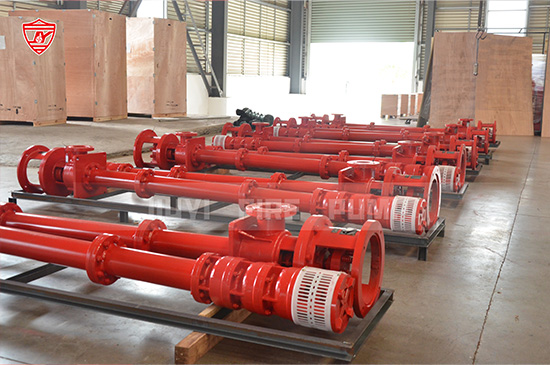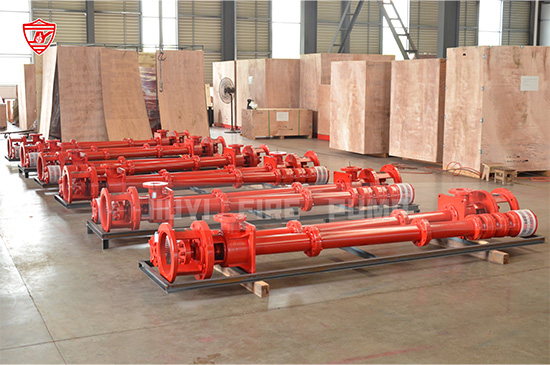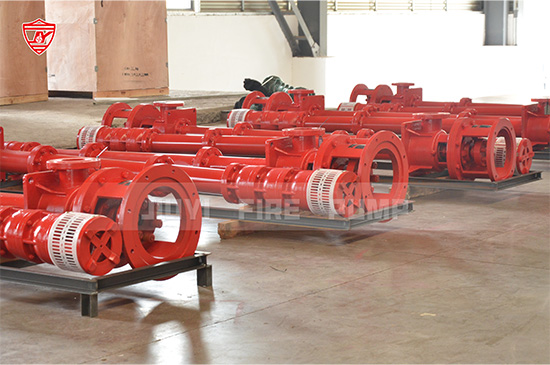In the fire protection industry, vertical turbine pumps (VTPs) are widely used for large-scale fire systems, especially when the water source is below ground level, such as tanks, reservoirs, or wells. Their ability to lift water from deep sources makes them a preferred choice in many fire protection designs.
However, like any technology, vertical turbine fire pumps are not without drawbacks. While they provide high efficiency and reliable performance in many scenarios, they also have limitations that engineers, designers, and facility managers need to consider before selecting them for a fire protection system.
In this article, we’ll explore the disadvantages of vertical turbine pumps, compare them to alternative fire pump types, and provide insights to help you make informed decisions.

One of the most significant disadvantages of vertical turbine pumps is their higher upfront cost compared to other fire pump options, such as horizontal split-case pumps or end-suction pumps.
Expensive components: The long pump shafts, column bearings, and discharge heads require precision manufacturing and premium materials, especially when UL/FM certification is needed for fire protection.
Specialized installation: VTPs require careful alignment and precise assembly, often involving cranes or other lifting equipment.
Longer commissioning time: Setting up the column pipe, shaft, and motor requires more expertise and labor, which increases the overall project cost.
For smaller facilities or projects with limited budgets, these costs may make vertical turbine pumps less attractive compared to simpler fire pump designs.
Vertical turbine pumps are installed vertically over a sump, tank, or reservoir, which often demands more floor-to-ceiling height and structural considerations than other pump types.
Pump room design challenges: Fire pump rooms must be designed to accommodate the vertical motor, column assembly, and discharge piping.
Heavy foundation needs: Since VTPs are taller and heavier, they require a reinforced base and proper vibration control.
Space restrictions: For buildings with limited mechanical room space, a horizontal split-case fire pump might be a more practical option.
This means project designers need to allocate additional space and resources when considering VTPs for fire protection systems.
Unlike horizontal fire pumps, vertical turbine pumps have more moving parts, which can make maintenance more challenging:
Shaft bearings and lubrication: VTPs require lubrication for their column bearings, which can be either water-lubricated or oil-lubricated. Oil-lubricated systems, in particular, require regular inspections to prevent leaks and contamination.
Difficult access: Since most of the pump components are submerged below the discharge head, accessing parts for inspection or repair can be time-consuming.
Higher spare parts cost: Specialized components, such as line shaft bearings, column pipes, and head shafts, are usually more expensive and may have longer lead times.
For facilities aiming to minimize long-term operational costs, this can be a critical factor when deciding between vertical turbine and horizontal fire pumps.
Vertical turbine fire pumps tend to produce more vibration and noise than horizontal pumps, especially at higher capacities. Without proper balancing and alignment during installation, this issue can worsen over time.
Noise-sensitive environments: For locations like hospitals, hotels, and residential complexes, this could be a significant disadvantage.
Additional vibration isolation: Engineers may need to incorporate advanced vibration-damping solutions, which further increases costs.
While these challenges can be mitigated with proper engineering, they still add complexity to system design and installation.

While vertical turbine pumps excel when the water source is below ground level, they are not always the best choice for all fire protection systems.
Not ideal for shallow water sources: If your firewater source is above grade or at ground level, a horizontal split-case pump or end-suction pump is usually simpler and more cost-effective.
Less efficient for smaller systems: For low-flow fire protection systems, the cost and complexity of VTPs often outweigh their benefits.
Site-specific restrictions: In some jurisdictions, building codes and fire protection standards may favor other pump configurations depending on the project.
Therefore, selecting a vertical turbine pump without a thorough analysis of your site and system needs can lead to unnecessary expenses and design complications.
Because vertical turbine fire pumps are custom-engineered for each application, they typically have longer manufacturing and delivery times than standard horizontal fire pumps.
UL/FM certification requirements: Certified VTPs require rigorous testing and approval, which can add weeks to production timelines.
Supply chain complexity: Obtaining replacement parts, especially shafts and column bearings, can also be slower due to limited availability.
For projects with tight deadlines, this can present significant scheduling risks.
Although vertical turbine pumps can be efficient in deep-water applications, they are less energy-efficient when the water source is relatively shallow.
Higher power consumption: Since VTPs are designed to lift water vertically, using them for shallow sources can result in unnecessary energy waste.
Oversizing risks: Engineers sometimes over-specify VTPs, leading to excessive motor sizes and higher operational costs.
In these cases, horizontal split-case fire pumps or vertical inline pumps may provide better energy efficiency.
Not all installers and maintenance teams are familiar with vertical turbine fire pumps, especially in regions where they are less commonly used.
Specialized expertise needed: Proper installation, alignment, and troubleshooting require trained professionals.
Training and certification: Facility operators may need additional training to ensure correct operation and maintenance practices.
Risk of improper setup: Inexperienced technicians can cause premature wear, vibration issues, and reduced performance.
For remote areas or regions with limited access to skilled labor, this can be a significant disadvantage.
| Feature | Vertical Turbine Pump | Horizontal Split-Case Pump |
|---|---|---|
| Water source location | Best for deep or below-ground sources | Best for above-ground or pressurized sources |
| Installation complexity | High | Moderate |
| Initial cost | Higher | Lower |
| Maintenance difficulty | More complex | Easier |
| Space requirements | Taller, needs high ceilings | Shorter, more compact |
| Lead time | Longer | Shorter |
| Energy efficiency | Best for deep lifts | Best for shallow lifts |
| Noise & vibration | Higher | Lower |
Vertical turbine fire pumps are a powerful and reliable solution when the water source is deep below ground, but they are not always the most practical choice for every fire protection system.
Before choosing a VTP, consider these factors:
Project budget and timelines
Available installation space
Maintenance capabilities
Water source location
Energy efficiency goals
For many projects, a horizontal split-case pump or vertical inline pump may be a better fit, especially when the water source is shallow or when minimizing installation and maintenance costs is a priority.

While vertical turbine pumps offer excellent performance in certain fire protection scenarios, understanding their disadvantages is critical to making the right decision for your facility.
At Better Technology Group, we specialize in manufacturing a wide range of UL/FM-approved fire pumps, including vertical turbine pumps, horizontal split-case pumps, and end-suction pumps. Our engineering team can help you evaluate your system requirements and select the most cost-effective and efficient solution for your fire protection needs.